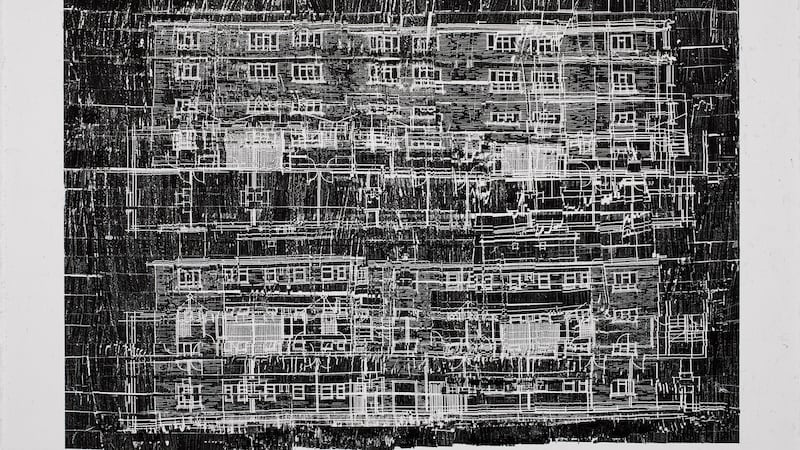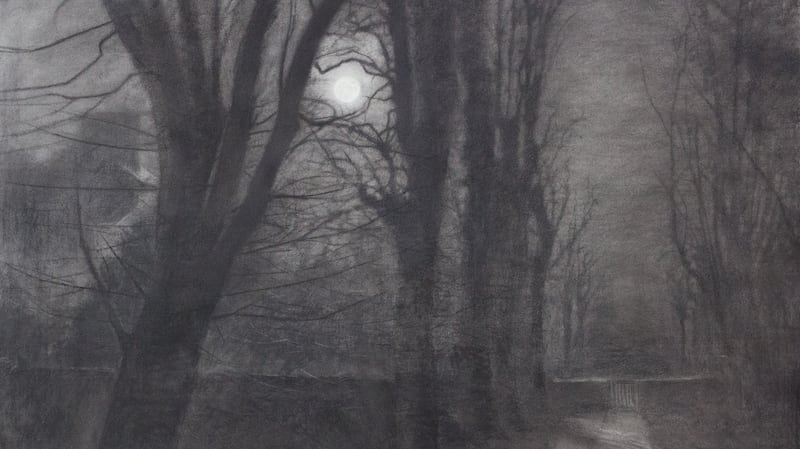Something for Nothing – Sheila Rennick
Hillsboro Fine Art, Dublin
****


Sheila Rennick’s paintings make fun of some of the cultural peculiarities of our age and – in a not-unrelated way – of timeless human foibles and delusions.
She takes aim at the hedonistic excess of turbo-charged consumerism, our helpless addiction to social-media crazes and our laughably skewed notions of ourselves. In vivid, often hallucinogenic images, she lays on swirling concentrations of sickly sweet pastel colours, intermittently built into succulently creamy impasto heaps, to the extent that the results should be cloying and unpleasant but actually inspire admiration for her sure judgment.
The characters she describes are exaggerated and deluded, but she doesn't simply ridicule them, no matter how much they seem to do so themselves. She doesn't assume or project a facile sense of moral or aesthetic superiority. There is some savagery to her humour, but a quality of objective analysis – and self-analysis – comes through, in a way that recalls the tone of Restoration comedy, Augustan literature or the incisive satire of A Rake's Progress and Hogarth's other moral tales.
There’s always a larger social vision and dimension. In the past she has used anthropomorphic animals as human characters, but the signs are that, although a level of ambiguity persists, the species are moving apart in her current work.
Animals have not disappeared. She has a wonderfully compassionate study of an urban fox, and another of a little fluffy dog. Despite her capacity to skewer arrogance and pretension, similar levels of compassion and sympathy are evident in her treatment of her human subjects. Her work has intellectual and emotional breadth.
- Until February 13th, hillsborofineart.com
Revisions – Julie Merriman
Dublin City Gallery, The Hugh Lane
****
In Julie Merriman’s drawings the ideal of order, whether manifest in the small-scale rendering of a mechanical part or in more lavish schemes of utopian town planning, is always undercut. Yet something rich and fruitful, if flawed – perhaps necessarily flawed – emerges in its place.
She looks to the moments when theory meets practice, order brushes against chaos and dreams encounter reality. She is relatively unusual in that drawing is the heart and substance of her practice as an artist. More, drawing itself, as used in disciplines including architecture, engineering, cartography and the sciences, is to a large extent her subject.
Her show Revisions, perhaps a perfect title for her entire approach, stems from a year-long involvement with departments of Dublin City Council, where she absorbed how drawing is employed on a day-to-day basis, and looking to the arrival of computer-aided design programmes, which have largely displaced and devalued manual drawing.
She has come up with a great, subtle body of work. The physical substance of the drawings – web-like, delicate and linear – is quiet and understated.
You must give yourself time to enter into the visual rhythm of what Merriman is doing, which is, to borrow a phrase from Polonius, “By indirections find directions out”. In making her drawings, Merriman worked through a filter of 16mm wide lengths of manual typewriter carbon film, enlisting a redundant technology to explore the potential of a diminished art.
As she puts it, she likes the "slippage" that the intervening carbon medium introduces, the uncertainty that the interruption creates. Her drawings happen in that gap. Several, such as Dr RP 1465/-1 or Construction II (Bridge) are quietly dazzling. Almost all are rich and absorbing.
- Until April 10th, hughlane.ie
The Return – Maeve McCarthy
Ashford Gallery, Dublin
****
Although Maeve McCarthy is best known for her small-scale paintings, including immensely atmospheric studies of rural locations by night, she turns to drawing for The Return.
The return is her own, from a Kerry village – the setting for most of her recent work – to Dublin and to tending her late mother’s garden in Glenageary. She also revisited the farmhouse near Newry where her grandmother grew up before moving south in the 1920s. The family spent time there every summer.
McCarthy, who has worked in film animation in Ireland and Germany, travelled north with her brother Peter, a film-maker. The house, long abandoned but still standing, is the setting for the short, meditative film that gives the show its title. Sounds and images gently hint at recollections of lives lived there, losses and departures and the finality of time.
Six large charcoal drawings feature the two family settings, north and south, by night. A mass of hydrangea blossoms glows luminously in the moonlight. In the soft, intricate layering of muted tones, McCarthy creates calm, accommodating spaces that allow for memories and reflection.
- Until February 21st, rhagallery.ie












